Alec Bray
I have been reading David Kynaston’s monumental history of Britain from 1945 to 1979 – “Tales Of a New Jerusalem” – but I have been reading them out of order (there IS a reason!). I have just stared on the volume “Modernity Britain” which covers the period 1957 to 1962 the period when I was at secondary school, going on to “A” levels and then applying to the BBC.
In this volume, there is an intriguing photograph – election night 1959, copyright BBC Photo Library). Richard Dimbleby is prominent on the main desk. Behind him is a stage manager – but I would have expected Mother to be the principal Floor Manager/Stage Manager for this production.
The camera on the LEFT is a Marconi Mk III Image Orthicon camera with a manual TTH Varotal Zoom lens. The camera on the RIGHT is an EMI Emitron (Camera 7).
That would give a nice mix of image quality, the IO giving much more contrasty pictures than the Emitron. There seems to be a camera on a crane – the camera cable can be seen hanging down on the right side of the picture.
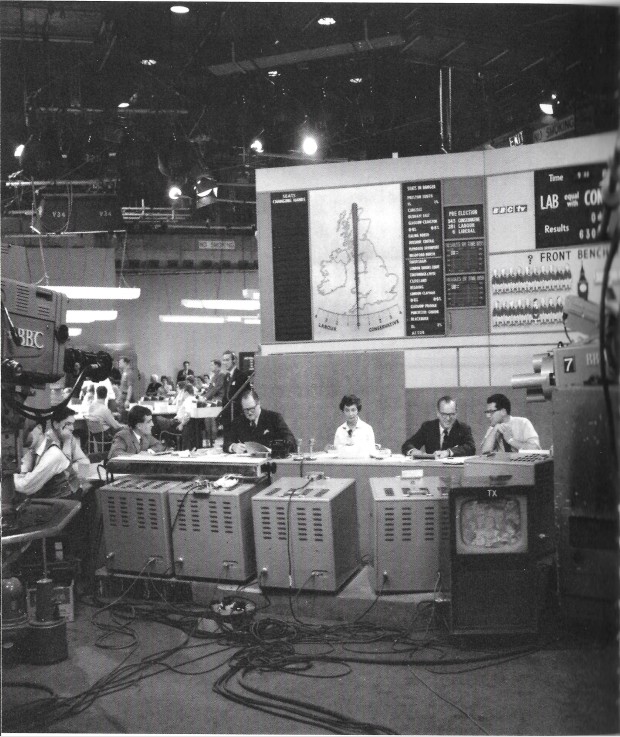
Now – WHICH STUDIO ??
It is obviously a large studio, either R1 or LG G. I would rule out LG G since the lighting barrels do not seem to be rope hung, which they were until the studio was refurbished with EMI 203 IOs – also since the Emitron camera is Camera 7 which puts it down in the priority order. Also the studio would need a vision mixing desk capable of handling that number of camera inputs. As I recall, LG G (and D and E at the time) were quite limited (as they were in 1963…)
Below is R1’s production gallery from the tvstudiohistory.co.uk website.
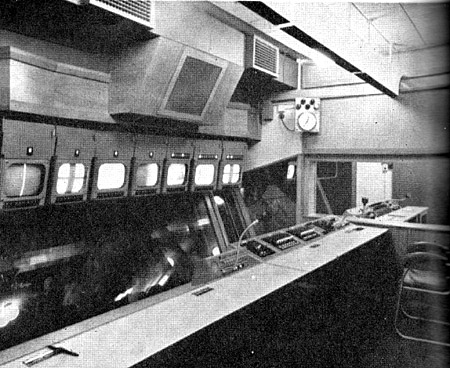
I simply can not remember if it was like this in the time I was there, but the mixing console looks capable of dealing with multiple sources.
I guess that there are not that many people left who might remember…
Graeme Wall
The Marconi Mk III appears to be on mole crane.
Alec Bray
Doing a bit more research – I found that this election broadcast is on the BBC i-Player! (this was recorded – and just think of all those programmes that were never kept …) BTW the polls closed at 9 o’clock (21:00) in 1959.
And the studio is — Lime Grove!! Richard Dimbleby says “Here, in the Lime Grove Studio…” Must be G. Some more pictures:
Emitron Camera 3:
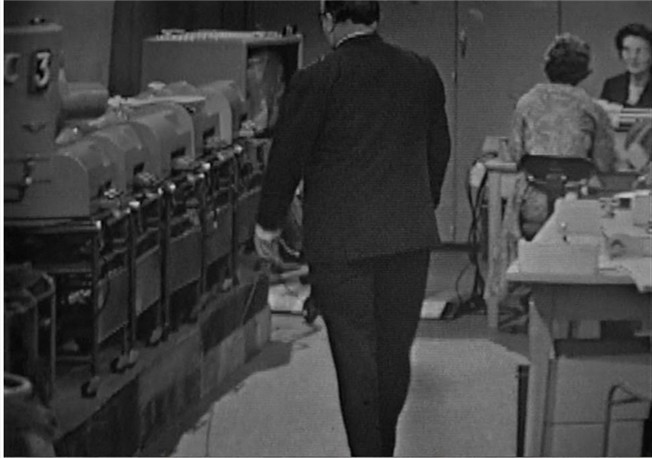
Marconi Mk III – camera 9 (9!!) – looks like it might be on a crane – and it seems to have a motorised Zoom of some sort:
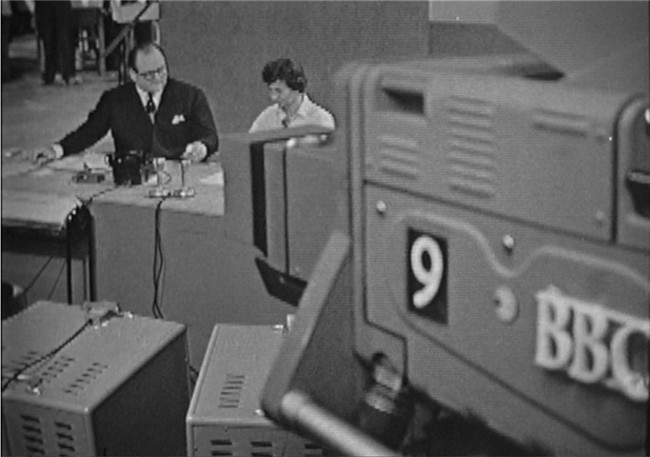
Bob Mackenzie introduces the Swingometer …
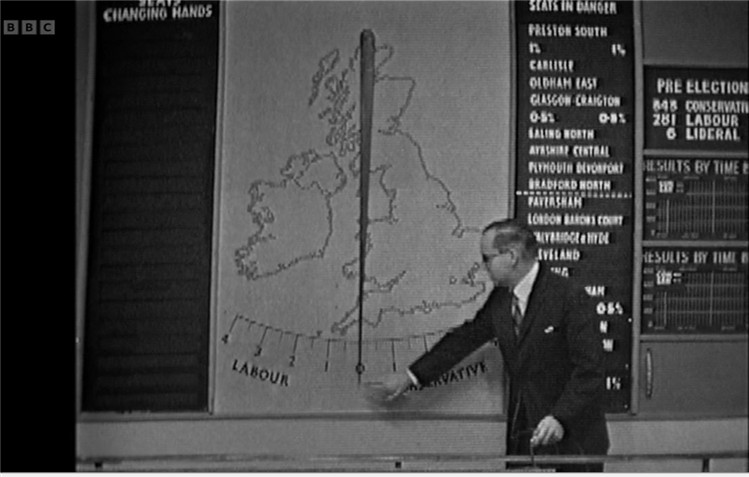
Barry Bonner
I think it maybe Studio E as it had been fitted out the previous year for Grandstand and had lots of GPO lines and teleprinter ports fitted which would have been needed for the election.
Studio G was oblong and not very wide, the sound desk probably wasn’t up to the task.
Alasdair Lawrance
I’m not an expert, but the lens on Camera 9 I saw when I was in Wales.
It was a zoom possibly by Watson rather than Taylor-Hobson and the whole turret assembly of the camera had to be removed to fit it, a right fag.
I don’t recall much more about it, and I think the metallic tube visible is for zoom with a similar, also un- adjustable, tube on the other side for focus, but the memory plays tricks and the controls may have been reversed.
(That was always an annoyance with the CPS camera, focus was on the left, not the conventional/normal on the right.)
The number 9 on the Mk III seems to be stuck on, not interchangeable as was common later on. No idea what the reason might be. One of a number of cameras sent for approval by R&D, or were the early Mk IIIs very unreliable, and you needed that many as spares, or to be cannibalised?
Alec Bray
The information that is available about the Watson zoom seems to indicate (can’t be absolutely sure) that is was mounted on a skid and used one of the camera lenses as one of the elements of the zoom: certainly the Watson was around at this time.
But Alasdair’s comment set off ANOTHER search! What about this one? (BBC Heritage Collection)
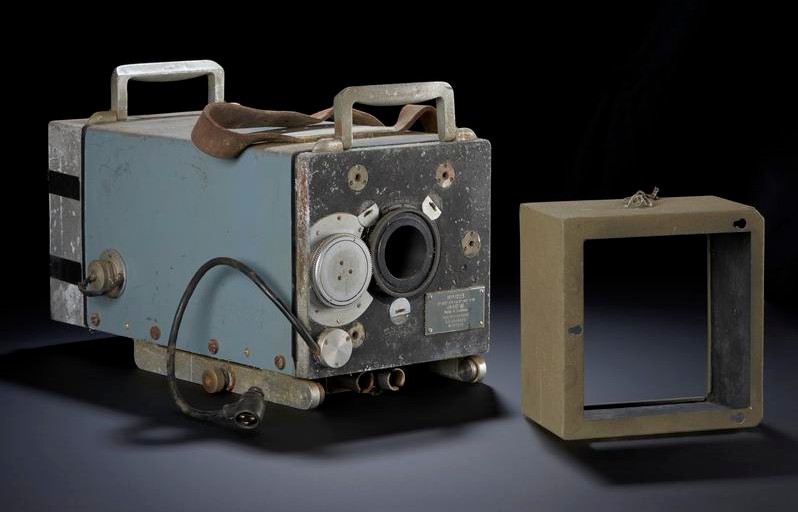
That brown box or lens hood (detached from the lens body) looks a bit like the lens hood showing on camera 9, the Marconi mk III.
The description of this lens in the Science Museum’s words is:
“… Varotal 1 Zoom lens, Ser. No: 517265. Following on from the Wilson zoom lens (used on Pye MK IIIs in the late 1950s) the Varotal 1 offered much improved quality and a greater zoom range. With a choice of interchangeable rear lens elements, operators could chose between 4″ to 20″ or (with less brightness) 8″ to 40″. Often used on the front of a Marconi MKIII (with a special adaptor plate – missing in this example)…” Marconi Mk III … special adaptor plate – that last part would certainly chime with Alasdair’s comments!
Golden Age TV has one for hire, and its Web site says:
“…The TTH Varotal Mk 1 zoom lens was designed in the mid-1950s for use with Image Orthicon cameras, (Marconi Mk III, Pye Mk 3 etc.) The Varotal Mk 1 had an optical range of 4″ to 20″ inches and with an adapter, 8″ to 40″ inches at f/4.5. The zoom was mounted using a dedicated camera bolt-on front plate or sledge. Controls were by enclosed linked rods fitted to each side of the camera. The example pictured was owned originally in 1955 by Associated-Rediffusion at their Wembley studios. Initially, A-R only had this one zoom, which was shared between the studios and ob dept…”
The description here fits even better with Alasdair’s comments – “… enclosed linked rods…dedicated camera bolt-on front plate …”
More research …
from the www.tvstudiohistory.co.uk/bbc-studios-in-london/lime-grove/ website:
“… Studio E opened on 21st August 1953 with four Marconi Mk III Image-Orthicon cameras: Studio E had its Marconis replaced with CPS Emitron Mk3s in 1959…”
– but when? The election was on 08th October 1959.
But the studio used was actually Studio G:
“…For the first time the latest computer technology was used to speed up and elaborate the statistical analysis of the election results on television. Unlike the 1955 election, where declarations were phoned in from the BBC’s News teams across London to Egton House (next to Broadcasting House), in 1959 teleprinters were installed into Studio G at Lime Grove ”
www.bbc.com/historyofthebbc/100-voices/elections/invention-2
And then we have Michael Peacock’s report on the programme:
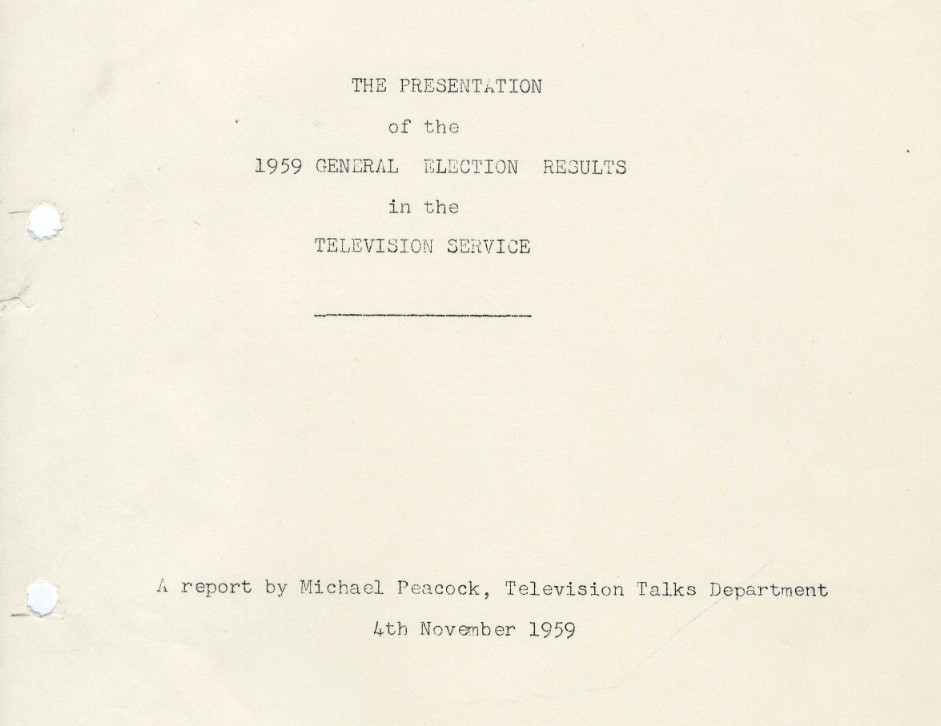

1959 is generally regarded as the first television election: that year, for the first time, the majority of voters owned TV sets.
“Billericay Declared First”
“… The 1959 election was the first election covered by commercial television and the BBC pulled out all the stops to make this a massive occasion which set the tone for all subsequent General Elections in the UK. The operation involved 55 cameras positioned around the UK and was anchored by Richard Dimbleby in the studio together with Robert McKenzie. There were teams at Party Headquarters and at key constituencies with reporters like Cliff Mitchelmore, Alan Wicker, Fyfe Robertson, Robert Kee, David Coleman, Raymond Baxter as well as Lord Boothby and Herbert Morrison ”
ITV’s first election programme in 1959 was “amazingly” preserved on videotape rather than film telerecording.
Wikipedia has this:
” The 1959 general election was the first election to be covered by commercial television in the United Kingdom. The ITV network provided election night coverage from the studios of Independent Television News (ITN) in London, with ITV given permission by the Independent Television Authority to use all of the ITV companies on air in 1959 for election links to the main studio in London. Ian Trethowan was the presenter for the ITV coverage ”
There were no adverts during the programme.
Patrick Heigham
I think it was ‘G’ as the ‘G’randstand studio had all the tielines and GPO lines installed for sports coverage, which would have been suitable for election results.
Alasdair Lawrance
Replacing Marconi IIIs with Emitrons? Isn’t that the wrong way round?
Dave Newbitt
When I joined in 1962 Limegrove ‘G’ had CPS Emitrons.
Chris Glass
My abiding memory of lime grove (1960) is the “C” Spanners to tighten up the camera cables, which alway seem to end up slipping and taking the skin off my knuckles. ( I have the scars to prove it).
Geoff Fletcher
Yes – same here about the C Spanners Chris. The screw heads holding the cable outputs to the “wheel” on the walls all had burred tops at their slot edges where the wrong screwdriver had been used on them over the years. Cut your knuckles like razors when using the C Spanner if not careful! When I joined in October 1963 there was just one studio left using Emitrons – at Lime Grove.
Peter Hider
Wall boxes nearly did for me in Line Grove.
The MPRC Mole CRANE ran off 110v DC and had its own wallbox supply.
For some reason I was rigging a Mole in G by myself and as I touched the mole power cable onto the box I took a 410volt DC phase belt through my arm. I went to the Sister who took my temperature. It read 105F. She said if my heart had been on the upbeat I’d have been brown bread. The whole wallbox was live. I’m still here 60 years later!
Peter Fox
I would guess that an OB van could be parked in Smiths Yard next door to G and supply a handful of Marconis to augment the 4 Emitrons? The mind boggles at uprooting and transporting full camera channels from Riverside or TV theatre. I recall D having CPS up until late 1963 but not sure about E. I associate E with EMI 203s I started in October 62 but it could have been just changing over from Emitrons in 62/63? And how about the option of dangling cables down the outside walls (been there done that later) to add some Emitrons?
I missed the Peacock bit about Studio H I had assumed those enormous RCA colour cameras had been there forever!
Dave Buckley
Has anyone else read Michael Peacock’s report on the programme?
I found it very informative, particularly the fact that a computer had been used during the programme to produce various statistics. Apparently, the results were available in around 20 seconds after input!
Graeme Wall
Presumably something like a Ferranti mainframe.
Paul Thackray
No!
A National-Elliott 402F Designed in Borehamwood.
Alec Bray
More detail from Michael Peacock’s report:

Paul Thackray
Elliott was merged with English Electric, with half the company becoming part of ICL. This was sold to Fujitsu who created the Horizon system for the Post Office.
Do you think the Elliott computer had a team of experts behind the scenes ‘correcting’ the results of the Election”



